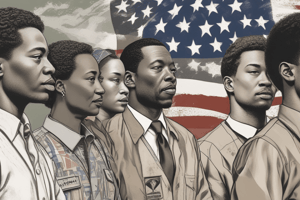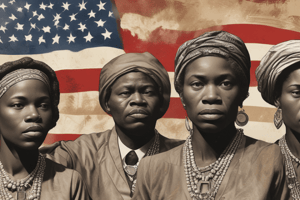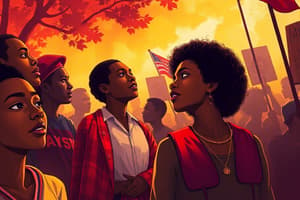Podcast
Questions and Answers
What was the outcome of the Supreme Court case Brown v. Board of Education?
What was the outcome of the Supreme Court case Brown v. Board of Education?
- It allowed racial discrimination in voting.
- It prohibited discrimination on the basis of religion in public schools.
- It established the principle of 'separate but equal' in public schools.
- It ruled that segregation of public schools based on race was unconstitutional. (correct)
What was the main objective of the Freedom Riders?
What was the main objective of the Freedom Riders?
- To protest racial discrimination in voting.
- To organize a bus boycott in Montgomery, Alabama.
- To board buses and ride them throughout the south protesting segregated bus terminals. (correct)
- To establish a non-violent civil rights organization.
Which Civil Rights organization was started by African American college students in 1960?
Which Civil Rights organization was started by African American college students in 1960?
- Little Rock 9
- Student Nonviolent Coordinating Committee (correct)
- Freedom Riders
- Montgomery Bus Boycott
Who wrote a famous letter arguing that 'there are two types of laws: just and unjust'?
Who wrote a famous letter arguing that 'there are two types of laws: just and unjust'?
What was the outcome of the Montgomery Bus Boycott?
What was the outcome of the Montgomery Bus Boycott?
What was the main goal of the Civil Rights Act of 1964?
What was the main goal of the Civil Rights Act of 1964?
Which court played a significant role in expanding the civil liberties Americans enjoy and exercise today?
Which court played a significant role in expanding the civil liberties Americans enjoy and exercise today?
Who were the first African American students to enter Little Rock's Central High School?
Who were the first African American students to enter Little Rock's Central High School?
What was the primary approach of President Hoover in addressing the Great Depression?
What was the primary approach of President Hoover in addressing the Great Depression?
What was the main consequence of the Stock Market Crash of 1929?
What was the main consequence of the Stock Market Crash of 1929?
What was the primary goal of FDR's Agricultural Adjustment Act?
What was the primary goal of FDR's Agricultural Adjustment Act?
What was the significance of FDR's 100 Days?
What was the significance of FDR's 100 Days?
What was the primary objective of the Civilian Conservation Corps?
What was the primary objective of the Civilian Conservation Corps?
What was the primary goal of Executive Order #9066?
What was the primary goal of Executive Order #9066?
What was the consequence of the widespread speculation in the stock market during the 1920s?
What was the consequence of the widespread speculation in the stock market during the 1920s?
What was the primary difference between FDR's approach to addressing the Great Depression and Hoover's approach?
What was the primary difference between FDR's approach to addressing the Great Depression and Hoover's approach?
What was the main objective of the Pacific Strategy?
What was the main objective of the Pacific Strategy?
What was the significance of the Battle of Midway?
What was the significance of the Battle of Midway?
What was the main goal of the Truman Doctrine?
What was the main goal of the Truman Doctrine?
What was the main characteristic of a communist state?
What was the main characteristic of a communist state?
What was the main objective of the Marshall Plan?
What was the main objective of the Marshall Plan?
What was the significance of the Korematsu v. United States case?
What was the significance of the Korematsu v. United States case?
What was the main goal of the Atlantic Strategy?
What was the main goal of the Atlantic Strategy?
What was the Holocaust?
What was the Holocaust?
Flashcards are hidden until you start studying
Study Notes
Civil Rights Movement
- Brown v. Board of Education: Supreme Court case that ruled segregation of public schools based on race was unconstitutional, overturning Plessy vs. Ferguson and "separate but equal" doctrine.
- Civil Rights Act of 1964: prohibited discrimination on the basis of race, color, religion, sex, or national origin.
- Voting Rights Act of 1965: prohibited racial discrimination in voting.
Key Events
- Montgomery Bus Boycott: organized by leaders of the local black community after Rosa Parks' arrest in 1955, it began the day she was convicted of violating segregation laws.
- Freedom Riders: teams of African American and white volunteers who protested segregated bus terminals in the South by boarding buses in Washington D.C. in 1960.
- Birmingham: site of Martin Luther King Jr.'s famous letter written while in jail, arguing that "there are two types of laws: just and unjust..."
- Little Rock 9: nine African American teenagers who integrated Little Rock's Central High School in 1957.
Key Figures
- Dr. Martin Luther King Jr.: prominent civil rights leader.
- Warren Court: ended racial segregation in U.S. public schools and expanded civil liberties through landmark rulings.
Presidential Initiatives
- New Frontier: Kennedy's domestic agenda aimed at changing life at home.
- Great Society: Warren Court's efforts to expand civil liberties and address racial discrimination, rights of the accused, and religious freedom.
The 1930s
- Hoover, the 30th President of the United States, attempted to pull America out of the Great Depression but became unpopular due to his approach of limited government intervention.
- Speculation, or high-risk investments, contributed to the Great Depression.
- The 1930s saw a focus on relief (immediate aid to the jobless), recovery (aid to banks, businesses, farmers, and workers), and reform (long-term economic changes).
FDR's New Deal
- FDR's New Deal consisted of programs and legislation aimed at economic recovery and social reform.
- The Stock Market Crash of 1929 caused the Great Depression, resulting in significant financial losses for investors and businesses.
Agricultural Adjustment Act and FDR's 100 Days
- The Agricultural Adjustment Act paid farmers to reduce crop production, increasing prices.
- FDR's first 100 days (March to June 1933) were crucial for addressing the Great Depression, with the implementation of New Deal programs focusing on economic stabilization, relief for the unemployed, and recovery efforts.
Civilian Conservation Corps
- The Civilian Conservation Corps provided jobs for young men, aged 18-21, in areas such as tree planting, bridge building, park development, and flood control projects.
WWII
Appeasement and Racial Equality
- Appeasement involved pacifying an aggrieved country through negotiation to prevent war.
- Executive Order #9066, signed by FDR, aimed to eliminate racial discrimination and segregation within the U.S. military.
Japanese-American Experience
- Nisei referred to second-generation Japanese Americans.
- The Korematsu v. United States case involved the internment of American citizens of Japanese descent and the removal of their constitutional protections.
Pacific War and Strategies
- Island Hopping involved seizing select Japanese-held islands in the Pacific while bypassing others.
- The Pacific Strategy focused on attaining positions for a full-scale offense against the Japanese homeland.
- The Atlantic Strategy aimed to starve Britain into submission by destroying merchant ships and their cargoes faster than they could be replaced.
Turning Points
- The Battle of Midway was a turning point in the Pacific, as the United States destroyed Japan's first-line carrier strength and most of its best-trained naval pilots.
- The turning point in the Atlantic was the shift in Germany's warships and submarines (U-boats) from focusing on sinking merchant shipping to reducing supplies reaching the UK and other European Allies.
Holocaust and US Generals
- The Holocaust was the Nazi attempt to kill all Jews under their control.
- Notable US generals during WWII included George Marshall, Dwight D. Eisenhower, Douglas MacArthur, and Omar Bradley.
Cold War
Truman Doctrine and NATO
- The Truman Doctrine stated that the United States would provide political, military, and economic assistance to democratic nations under threat from external or internal authoritarian forces.
- NATO focused on collective defense and protecting its members from potential threats from the Soviet Union.
Communism and Marshall Plan
- Communism involves a communist state administered from the center, with control of the economy and society strictly in the hands of the Communist Party-led government.
- The Marshall Plan was an American initiative to aid Western Europe, providing over $13 billion in economic assistance to rebuild Western European economies after WWII.
Studying That Suits You
Use AI to generate personalized quizzes and flashcards to suit your learning preferences.




